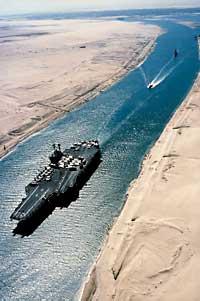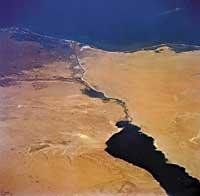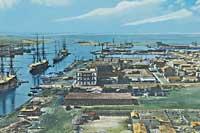Path to another sea

Napoleon, during his stay in Egypt, did not think of anything else. It occurred to him to build a fire channel and sent his engineers and scientists to calculate if possible. According to data, the Red Sea stood 10 meters above the Mediterranean, which frustrated Napoleon's dreams. So much difference in water level demanded to fill the locks channel, too many infrastructures to pass the vapors from one level to another. And Napoleon acknowledged that the work was too big.
Then they realized that at the level of the two seas there was not so much difference. Austrian engineer Negrelli showed that there was only a difference of 80 cm. This facilitated much and accelerated the canal's work, which soon became available to the Frenchman Ferdinand Lesseps.
Led by European engineers and with the sweat of the Egyptian workers, they managed to finish the channel in 10 years. A hole of 163 kilometers from the Mediterranean to the Gulf of Suez, taking advantage of the great lakes that emerged on the road. This was the case with the first steam in 1867. After the last touches, it was officially opened two years later. First passed the French engineer Lesseps and the wife of Napoleon III, and behind hundreds of vapors; those of Egypt, from most European countries, and many more. In fact, it distributed Africa and Asia, but it brought Europe and Asia closer.
The dream of the Pharaohs
In fact, when the canal began to be built, they realized that centuries before the Egyptians had also tried to open a similar path. Exposure of carbon test 14 in the XIX. Towards the twentieth century the Gulf of Suez was already joined with the eastern branch of the Nile River.

Subsequently, in this work, several Egyptian dynasties were attempted. Egypt was the heart of international trade. It linked the most important maritime routes in the world and saw that the channel was necessary to maintain commercial relations with other countries. But all the pharaohs had similar problems to build the canal: despite the hole, the water currents eroded the land and finally the sand covered the canal.
In the time of the pharaoh of Menes, in order to avoid this problem, they tried to cover the bed with wood and resins. Subsequently, the stone was used, where blocks of stone were placed to cover the bottom and the sides. But in the end the problem was again imposed. At the 38 centuries of the first attempts a stable channel was achieved, covering the walls with cement.
5,000 kilometers less
Despite the difficulties, the canal reduced the usual path of Europeans by 5,000 kilometers. The return of several months went on to take place in a few days, which made the channel the target of many countries. Especially from England, because they feared losing the privilege they had in India if they were in the hands of the French.
But then the French failed in the war against the Prussians and, to deal with the enormous expenses caused, put on sale the shares of the Suez Canal. The Egyptian authorities also had to sell their share in 1875 to pay for the government rake errors. They asked England if he wanted actions and, undoubtedly, he gave them the yes.

Benjamin Disraeli, English Prime Minister of the time, earned 4 million pounds of gold in record time, with most of the channel's actions from day to day. The future of the canal remained completely in the hands of England, and so it was until it completely abandoned India and Egypt. In fact, the Suez Canal was at that time one of the most important arteries of international traffic.





